Best Firewood for Heat 2024
- September 18, 2023
- 0 comment
Winter nights spent by a roaring fire evoke a sense of nostalgia. The crackling flames, the warmth enveloping you, and the mesmerizing dance of embers create an ambiance that’s hard to beat. But not all firewood is created equal. Choosing the right wood can mean the difference between a long-lasting, efficient blaze and a smoky, short-lived disappointment. Dive into this guide to discover the best firewood for heat, ensuring your hearth remains the heart of your home.
1. Hardwoods: The Gold Standard in Firewood
Oak
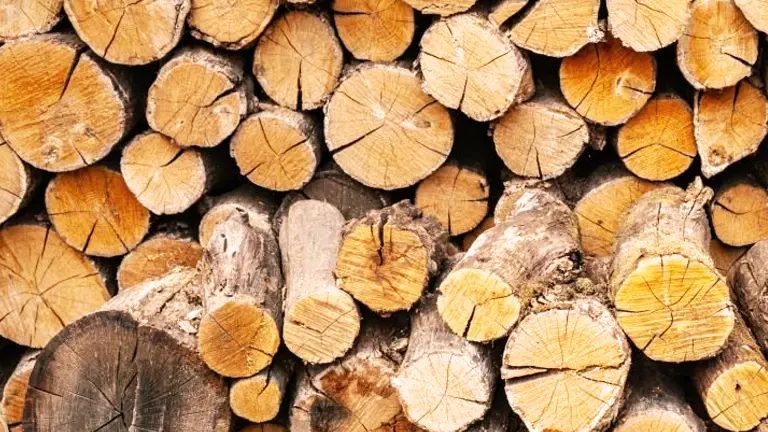
- Density: Oak is one of the densest woods available for burning, which directly impacts its burn time and heat output.
- Longevity When Burning: On average, a well-seasoned oak log can burn for approximately 3-4 hours in a controlled environment. However, this can vary based on the size of the log, its moisture content, and the specifics of the fireplace or stove.
- Heat Output (BTUs): Red oak, which is one of the most common types of oak used for firewood, has an estimated BTU value of about 24 million BTUs per cord. This value can vary somewhat among different oak species, with white oak generally producing slightly higher BTU values.
- Sparking and Safety: Oak’s tight grain structure results in fewer sparks than many other woods. This makes oak particularly desirable for open fireplaces where spark containment is an issue.
- Seasoning Period: Because of its density and moisture content, oak typically requires a longer seasoning period than many other hardwoods. While many woods are seasoned in 6 months, oak benefits from a seasoning period of 12 to 24 months. Seasoning for two years will often yield the best results in terms of heat output and reduced creosote risk.
- Aesthetic and Experience: The slow, even burn of oak provides a captivating view of rolling flames and glowing embers. Its consistent heat and minimal sparking make it perfect for cozying up next to on a cold evening, encapsulating both the warmth of the fire and the ambiance of the setting.
Maple
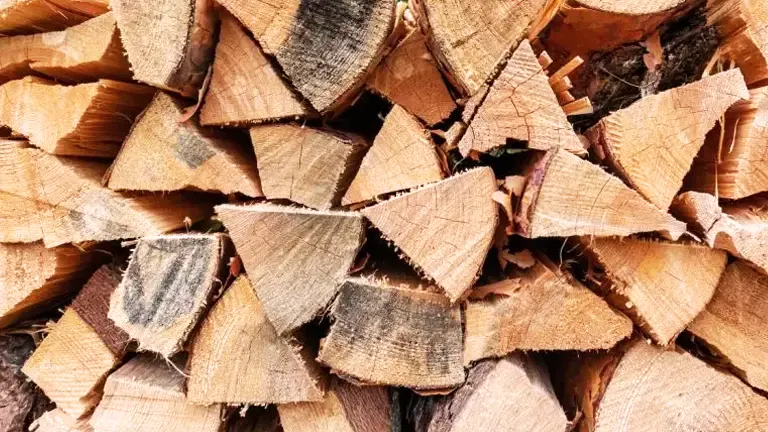
- Versatility: Maple is diverse with several species available for burning. Each of these species will have its slight variations in burn characteristics, but they generally share the traits of hardwoods.
- Longevity When Burning: Typically, a well-seasoned maple log can burn for approximately 2-3 hours in a controlled environment, though this varies with log size, moisture content, and fireplace specifics.
- Heat Output (BTUs):
- Sugar Maple: Among the hardwoods, sugar maple is often celebrated for its high BTU output, which is roughly 24 to 25 million BTUs per cord.
- Silver Maple: Slightly lower in comparison to sugar maple, silver maple yields around 19 to 20 million BTUs per cord.
- Other species of maple will fall within or around this range, with sugar maple generally at the higher end for heat output.
- Burn Quality: Maple’s tight grain structure ensures that it burns consistently and cleanly. The lesser sap content compared to resinous woods like pine means a reduced risk of creosote build-up.
- Seasoning Period: Maple requires a moderate seasoning period compared to other hardwoods. Generally, maple is best seasoned for 6 to 9 months to achieve optimal burning properties. Given its relatively lesser density than oak, it doesn’t require as extended a seasoning period.
- Ease of Splitting: Maple’s grain structure and hardness place it in a middle ground between the toughest hardwoods and softwoods. It’s generally easier to split than woods like oak or hickory, making it more user-friendly for those who process their own firewood.
Hickory
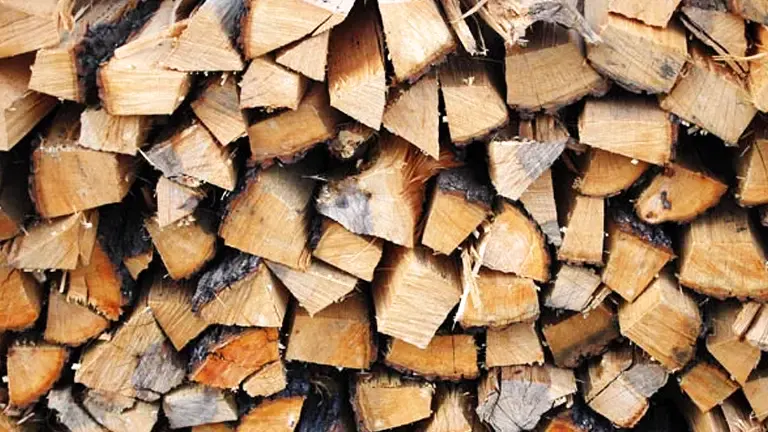
- Density: Hickory is among the densest North American hardwoods. This intrinsic property is not only its burn characteristics but also its workability.
- Longevity When Burning: A single log of well-seasoned hickory, given its density, can burn for approximately 3-5 hours in a controlled environment. The duration can fluctuate based on the size of the log, moisture content, and specifics of the burning apparatus.
- Heat Output (BTUs): Hickory is renowned for its high BTU content. Typically, you can expect hickory to yield about 24 to 27 million BTUs per cord. This superior BTU output, especially in comparison to many other hardwoods, ensures optimal warmth even in frigid temperatures.
- Aroma: When burned, hickory produces a unique, smoky aroma that is often associated with smoked foods. It’s no coincidence that hickory wood is a favorite for smoking meats, lending them that distinct, sought-after flavor.
- Seasoning Period: Hickory benefits from a seasoning duration similar to oak due to its dense nature. For best results in burning efficiency and aroma, hickory should be seasoned for 12 to 24 months. This extended period ensures that the wood’s moisture content is optimal for burning.
- Workability: Hickory’s density, while a boon for burning, can be a challenge when it comes to splitting. It is tougher than many other hardwoods, which can make the splitting process more labor-intensive. However, as many seasoned wood burners would attest, the resulting heat and aromatic experience more than compensate for the initial effort.
| Characteristic | Oak | Maple | Hickory |
|---|---|---|---|
| Density | Very Dense | Moderately Dense | Very Dense |
| Burn Time | Long | Medium to Long | Long |
| Heat Output (BTUs) | High | High | Very High |
| Ease of Splitting | Moderate (depends on species) | Easier than Oak and Hickory | Challenging due to toughness |
| Spark Production | Minimal | Minimal | Minimal |
| Aroma When Burned | Mild, Woody | Mild with a hint of sweetness | Rich, Smoky (reminiscent of smoked meats) |
| Seasoning Time | Extended (1-2 years for optimal results) | Moderate (6 months to a year) | Extended (1-2 years for optimal results) |
| Creosote Buildup Risk | Low to Moderate (with proper seasoning) | Low | Low to Moderate (with proper seasoning) |
| Availability | Widely available in many regions | Widely available, especially in North America | Available but less common than Oak and Maple |
2. Fruitwoods: A Flavorful Burn
Fruitwoods, as the name suggests, come from trees that bear fruit. These woods are not just known for their heating abilities but also for the distinct aromatic scents they release when burned. They’re especially popular in smoking and barbecuing due to their unique aromatic properties.
Apple
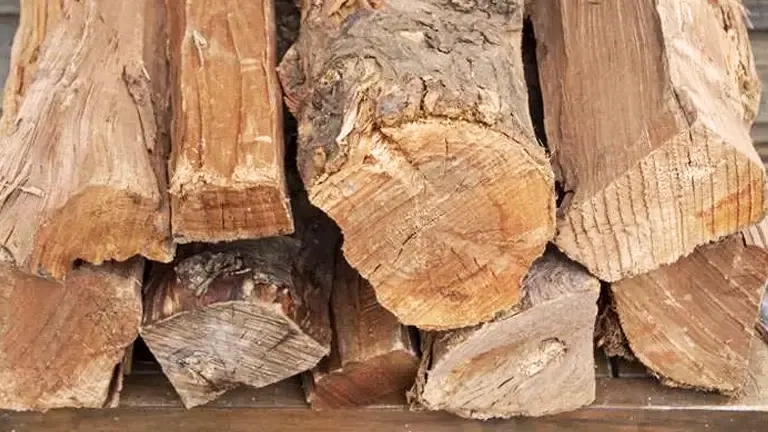
Applewood, commonly associated with orchards and delicious pies, has a revered place in the world of firewood. This wood, dense in its composition, ensures a slow and sustained burn, making it highly efficient for warmth. But what truly sets applewood apart is the aromatic experience it offers. When burned, it exudes a mild and sweet scent, reminiscent of sun-kissed apple orchards. This unique aroma not only enhances the ambiance of any room but also makes applewood a preferred choice for culinary smoking, imparting a subtle fruity note to foods. While it might not rival the intense heat output of heavy hardwoods like oak or hickory, applewood delivers reliable and pleasant warmth, making it a favorite for many.
Cherry
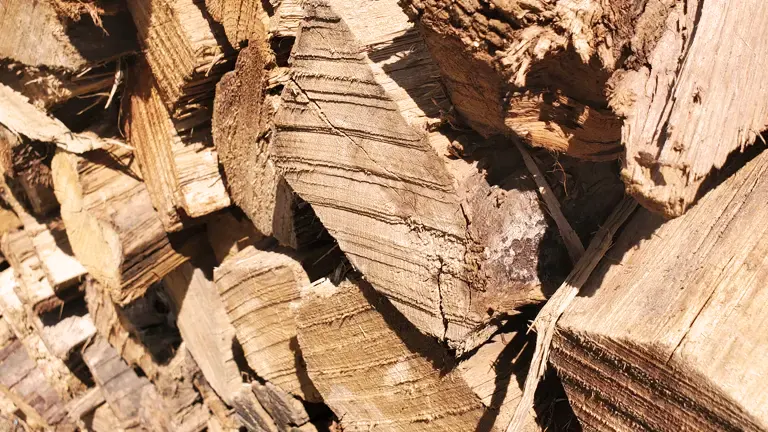
The allure of cherry wood goes beyond its rich, reddish hue which has made it a favorite in woodworking. As firewood, cherry not only looks good but performs admirably too. It burns at a steady, moderate rate, ensuring a consistent release of warmth. Its density, while not on par with the densest of hardwoods, offers a commendable burn duration. The true charm of cherry wood, however, lies in its aroma. When ignited, cherry wood gives off a gentle and sweet fragrance, turning an ordinary evening by the fire into a memorable sensory experience. While it may not be the absolute champion in terms of BTU output, cherry wood seamlessly combines its functional warmth with a delightful scent, making it a sought-after choice for those keen on a holistic fireplace experience.
3. Evergreens: A Word of Caution
Pine
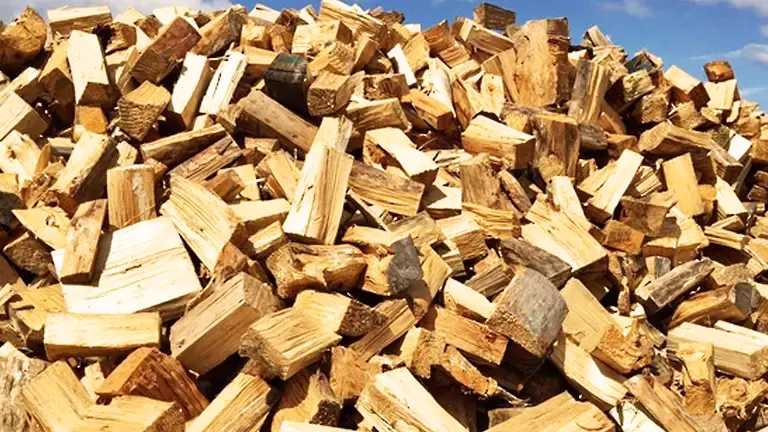
Pine, a staple in many forests, is a go-to for many, especially given its widespread availability. The wood from pine trees ignites easily, producing heat in a flash—a trait that’s particularly useful when you’re looking for immediate warmth. However, there’s a flip side to this benefit. Pine is rich in sap and resins, which, when burned, can release creosote—a flammable substance that has a tendency to accumulate in chimneys and flues. Over time, this buildup can pose a fire hazard, especially if the chimney isn’t regularly cleaned. Therefore, while pine is excellent for starting fires due to its quick ignition property, it’s essential to use it judiciously. It’s often recommended as kindling, setting the stage for other, less resinous woods to take over the main burn.
Fir
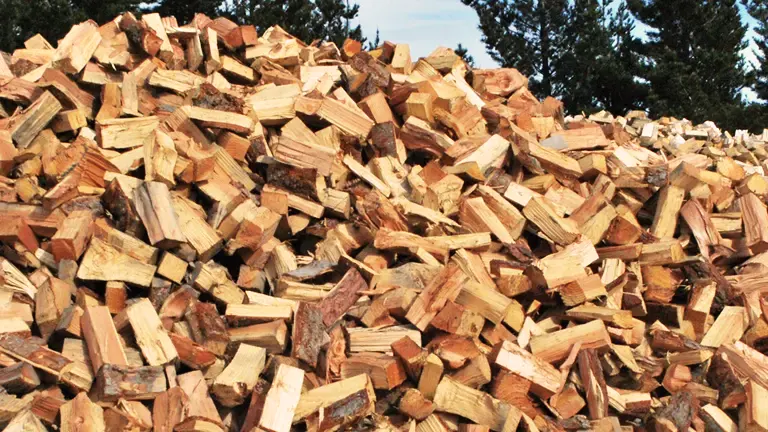
Fir trees, another member of the evergreen family, bear similarities to pine in their burning characteristics. When ignited, fir produces a burst of warmth, which can be quite inviting on a cold day. However, like pine, fir contains resins that, upon combustion, can lead to creosote deposits in the chimney. While it doesn’t mean fir shouldn’t be used, it’s a signal for users to be aware and intentional. One popular strategy with fir is to use it in tandem with hardwoods. Starting with fir provides that initial warmth, and then transitioning to hardwoods, like oak or maple, ensures a steady, prolonged burn without an excessive release of creosote. This pairing not only maximizes the heating potential but also minimizes potential risks
4. Seasoning: The Secret Ingredient
Wood, when freshly cut, is laden with moisture. This moisture content, while natural, can significantly impede the wood’s burning efficiency. Herein lies the magic of seasoning – the art and science of drying wood to optimize its burning properties.
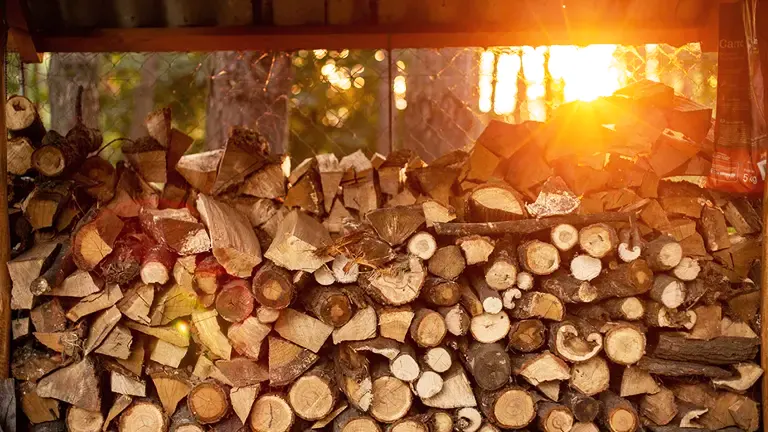
- Understanding Moisture: Freshly harvested wood can have a moisture content as high as 50% or even more. This means when you try to burn it, a substantial amount of the energy produced goes into evaporating this moisture, rather than providing heat. As a result, the wood sizzles, smokes excessively, and produces less heat.
- The 20% Benchmark: Seasoning aims to bring the moisture content below the coveted 20% mark. At this level, the wood is primed to burn efficiently. It catches fire easily, burns hotter, and emits fewer pollutants. You’ll also notice less creosote buildup in your chimney, reducing maintenance and fire hazards.
- Time is Key: While six months is often considered a minimum seasoning period for many woods, patience is rewarded in this endeavor. Extending the seasoning to a year or even longer allows the wood to shed even more moisture, enhancing its burning qualities further. Think of it like aging wine; the longer you let it sit, the better the outcome.
- Storage Matters: Seasoning isn’t just about the duration. How you store the wood during this period can make a significant difference. Wood should be stacked in a way that allows air circulation, preferably in an open yet covered area to shield it from rain. Direct sunlight can also expedite the drying process.
5. Going Beyond the Burn: A Few Tips
Storage

One of the pillars of efficient wood burning is how the wood is stored. Placing wood directly on the ground exposes it to moisture from the soil, which can impede the drying process or reintroduce moisture to already seasoned wood. Elevated storage ensures the wood stays dry and extends its longevity. Moreover, a well-ventilated storage area, perhaps using pallets or a dedicated woodshed, allows air to circulate freely around the logs. This not only aids the seasoning process but also helps in keeping mold at bay, ensuring that the wood remains healthy and safe to burn.
Mix and Match
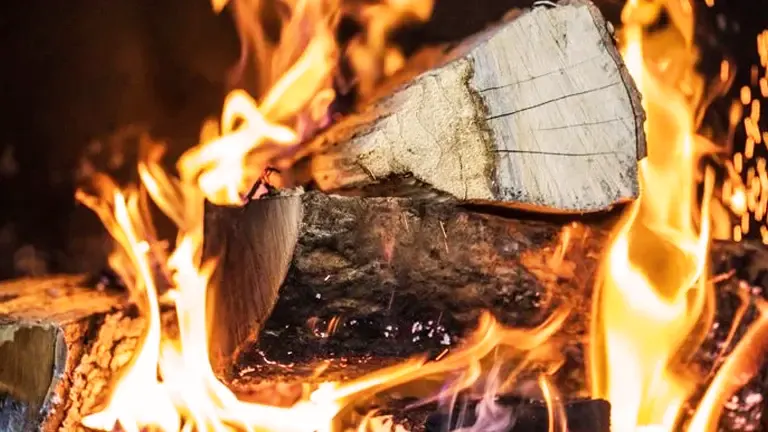
While each wood type has its distinct characteristics, there’s no rule against blending them. In fact, combining different woods can elevate the fire experience. For instance, using oak, renowned for its longevity in burning, as a base, and then introducing cherry can intertwine the persistent heat with a hint of cherry’s delightful aroma. This not only ensures the fire lasts but also turns it into a sensory experience, making the fireplace not just a source of warmth but also an aromatic centerpiece for the evening.
Safety First

The cozy comfort of a wood-burning hearth, while inviting, comes with responsibilities. One of the primary ones is ensuring the safety of the household. Over time, burning wood, especially resinous types, can lead to the accumulation of creosote in the chimney. This thick, tar-like substance is flammable and can spark chimney fires if left unchecked. Therefore, an annual chimney sweep is more than just a recommendation—it’s a necessity. Regular inspections and cleanings not only ensure that the fireplace operates at its peak efficiency but also guard against potential fire hazards, ensuring that the hearth remains a source of joy, not worry.
In Conclusion
Selecting the best firewood for heat isn’t just about warmth; it’s about the experience. By understanding the characteristics of different types of wood, you can ensure that every fire you light is efficient, aromatic, and mesmerizing. So, the next time you’re stocking up for winter, keep this guide in mind and elevate your fireside moments.
FAQs
- Why is hardwood generally preferred over softwood for heating?
Hardwoods, derived from deciduous trees like oak and maple, are denser and burn slower, producing consistent and long-lasting heat. Softwoods, on the other hand, tend to burn faster and hotter but for shorter durations. - Can firewood be too old to burn?
While seasoned wood is ideal for burning, wood that’s been left exposed to elements for many years can deteriorate or rot. While it may still burn, the heat output could be diminished, and it might produce more smoke. - Why is “seasoned” wood crucial for optimal burning?
Seasoning refers to the drying process, which reduces the moisture content in wood. Properly seasoned wood (with moisture content below 20%) burns more efficiently, produces more heat, and results in less creosote buildup in chimneys. - What’s the deal with creosote, and why should I be concerned?
Creosote is a tar-like substance that accumulates in chimneys from burning wood, especially from unseasoned or resinous wood. Excessive creosote buildup can be flammable, leading to chimney fires. - How does altitude affect firewood burning?
At higher altitudes, the air contains less oxygen, which can affect the combustion efficiency of wood. You might find that wood burns slightly faster and cooler in higher altitudes compared to sea level. - Are there any woods I should avoid burning?
Yes, woods like poison ivy, poison oak, or poison sumac release toxic fumes when burned. Additionally, treated or painted wood can release harmful chemicals into the air. - Can I use firewood ash in my garden?
Yes! Wood ash can be a good source of lime and potassium for gardens. However, ensure it’s pure wood ash without any additives or remnants from treated wood. - Does the bark of firewood matter when burning?
While bark doesn’t significantly impact the BTU value of the wood, it can influence how the wood ignites. Bark can act as an insulator, slowing down the initial catch. But, it can also be useful as kindling in some cases. - Why do some woods pop and crackle when burned?
This is often due to the sap content and trapped moisture in the wood. As the wood burns, the moisture turns to steam, and the sap becomes volatile, causing the wood to pop or crackle. - How does wood’s BTU rating influence its heating capability?
The BTU (British Thermal Unit) rating indicates the amount of heat energy a wood type produces when burned. Woods with higher BTU ratings provide more heat, making them more efficient for warming spaces.
We’d love to hear from you! Share your personal experiences and preferences on the best firewood for heat in 2024 in the comments section below. Your insights could help fellow homeowners choose the right wood for their heating needs!

David Murray
Forestry AuthorI'm David Murry, a forestry equipment specialist with a focus on chainsaw operation. With over 13 years of experience, I've honed my skills in operating and maintaining a wide range of machinery, from chainsaws to log splitters. My passion for the outdoors and commitment to sustainable forestry drive my work, which emphasizes safety, efficiency, and staying updated with industry advancements. Additionally, I'm dedicated to sharing my expertise and promoting environmental awareness within the forestry community.











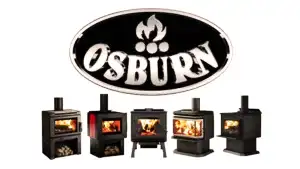
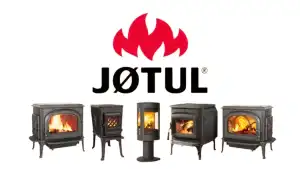
Leave your comment